CIMA CIMAPRA17-BA3-1-ENG BA3 – Fundamentals of Financial Accounting (2017 SYLLABUS) (Online) Online Training
CIMA CIMAPRA17-BA3-1-ENG Online Training
The questions for CIMAPRA17-BA3-1-ENG were last updated at Dec 30,2025.
- Exam Code: CIMAPRA17-BA3-1-ENG
- Exam Name: BA3 - Fundamentals of Financial Accounting (2017 SYLLABUS) (Online)
- Certification Provider: CIMA
- Latest update: Dec 30,2025
CORRECT TEXT
Refer to the Exhibit.
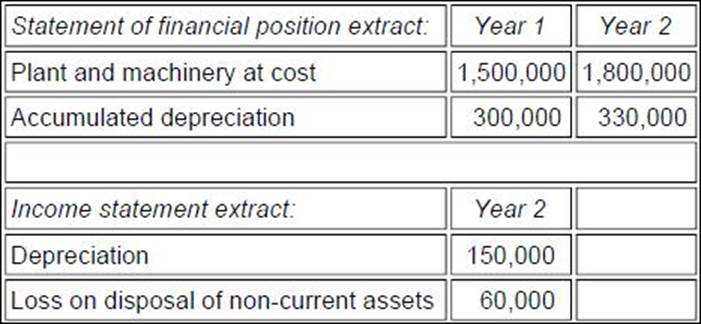
The following information is available relating to the non-current assets of Company X:
Non-current assets that had originally cost $225,000 and had a carrying value of $105,000 were sold during the year.
The figure for purchases of non-current assets to be shown in the statement of cash flows will be, to the nearest $1,000:
As well as independence other essential elements of internal audit can be identified.
Which THREE of the following would be classed as essential elements of internal audit?
- A . Due care
- B . Relationships
- C . Cost efficient
- D . Timely
- E . Evidence
- F . Efficient
Refer to the Exhibit.
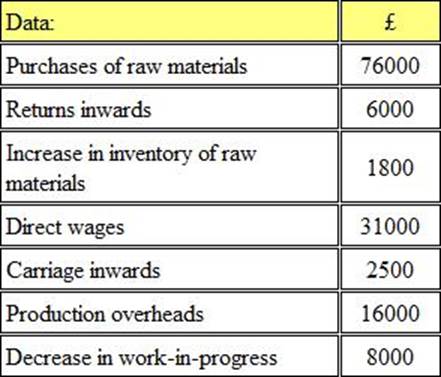
The following information is given at a manufacturer’s year end:
Using some or all of the above figures, the correct figure for factory cost of goods completed is:
- A . £115,700
- B . £125,700
- C . £131,700
- D . £135,300
A company purchases a piece of machinery for $180,000. It is estimated that the machinery will produce 450,000 units over its useful life of 10 years. The residual value at the end of 10 years is nil. After eight years, the machine has produced 340,000 units and is sold for $30,000.
The profit/loss arising on disposal of the asset is
- A . $6,000 loss
- B . $14,000 loss
- C . $14,000 profit
- D . $6,000 profit
Cost of goods sold for a manufacturing company is the total of
- A . prime costs + production overheads + opening work in progress – closing work in progress + opening inventories of finished goods – closing inventories of finished goods
- B . prime costs + production overheads + opening inventories of raw materials – closing inventories of raw materials + opening work in progress – closing work in progress
- C . prime costs + production overheads – opening work in progress + closing work in progress – opening inventories of finished goods + closing inventories of finished goods
- D . prime costs + production overheads + opening inventories of raw materials – closing inventories of raw materials + opening work in progress – closing work in progress + opening inventories of finished goods – closing inventories of finished goods
CORRECT TEXT
Refer to the Exhibit.

A company operates an AVCO system of inventory. Opening inventory at the beginning of the period was 400 units @ $6.50 per unit.
During the period, the following purchases and issues were recorded:
The amount charged to the company’s income statement in the period is
Refer to the Exhibit.
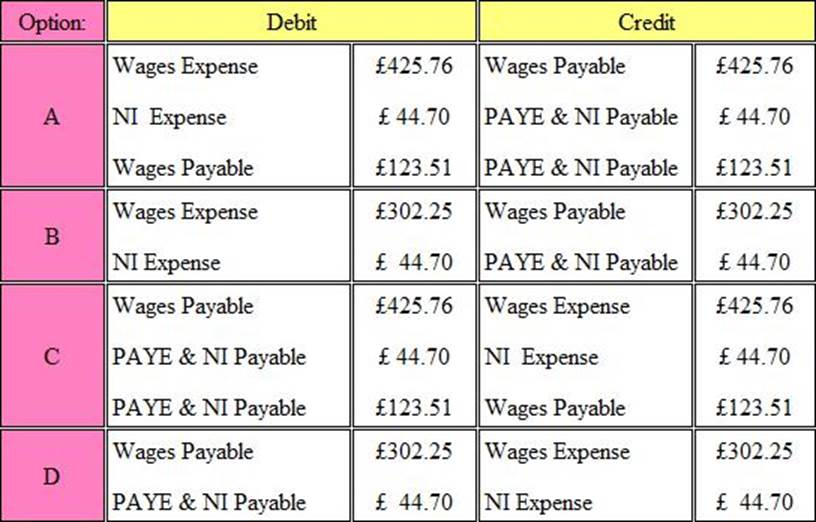
John, an employee of Kelt Ltd, earns gross wages for a week of £425.76.
Income tax is deducted at a rate of 25% on all earnings in excess of £85.00 per week and he is also liable to pay National Insurance contributions of 9% of his total earnings. Employers national insurance contributions are at a rate of 10.5%.
What are the correct ledger entries in the accounts of Kelt Ltd?
The answer is:
- A . Option A
- B . Option B
- C . Option C
- D . Option D
DEF prepares its financial statements to 30 September each year On 1 March 20X5 DEF acquires an office and immediately rents it to a tenant charging $2,400 a quarter payable in advance.
The tenant pays $2,400 on each of the following days 1 March 20X5, 6 June 20X5, 4 September 20X5 and 1 December 20X5.
What is the liability reported in the statement of financial position relating to the rent at 30 September 20X5?
- A . $7,200
- B . $1,600
- C . $4,000
- D . $5,600
Before lending to an entity, which TWO of the following pieces of information would a potential lender want to consider?
- A . Past tax payments made by the entity
- B . Social policies of the entity
- C . Dividend policy of the entity
- D . Ability of the entity to meet interest payments
- E . Long term business plans of the entity
A company which is VAT-registered receives an invoice for goods purchased for resale totaling $2,585 from a supplier that is not VAT-registered. VAT is at the rate of 17.5%.
The correct entry to record the invoice is:
A)
![]()
B)
![]()
C)
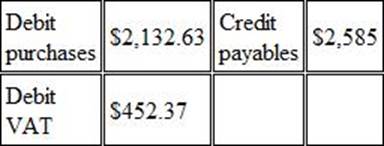
D)
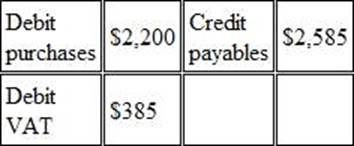
- A . Exhibit A
- B . Exhibit B
- C . Exhibit C
- D . Exhibit D
Latest CIMAPRA17-BA3-1-ENG Dumps Valid Version with 393 Q&As
Latest And Valid Q&A | Instant Download | Once Fail, Full Refund

